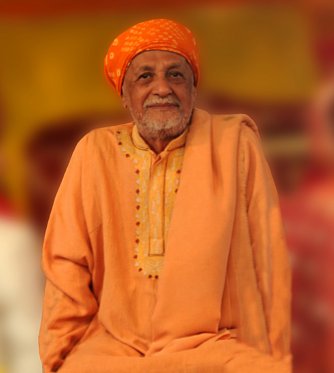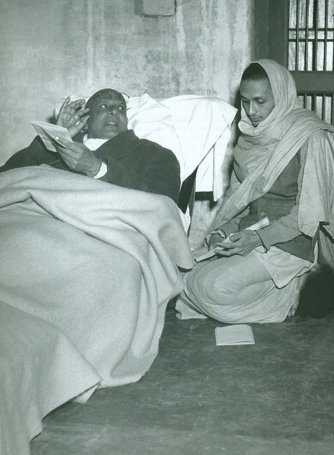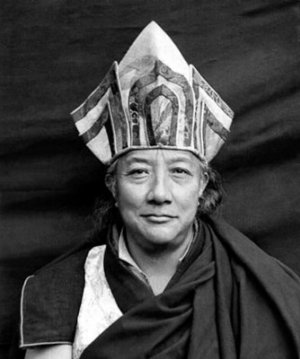| Library / Biographies |
Swami Satyānanda Saraswati Biography

Swami Satyānanda SaraswatiSatyānanda Saraswati was born on 25 December 1923 at Almora, Uttaranchal, into a family of farmers. As a youth he was classically educated and studied Sanskrit, the Vedas and the Upanishads. Saints and sadhus predicted he will be a spiritual person.
In one of his early publications, Yoga from Shore to Shore, he said: "One day I met a mahātma, a great saint, who was passing by my birthplace...So he told me I should find a guru."
At age eighteen, he left his home to seek a spiritual master. In 1943 at the age of twenty, he met his guru Swami Śivānanda Saraswati and went to live at Śivānanda's ashram in Rishikesh.
Śivānanda initiated him into the Daśanāmi Order of Saṃnyāsa1 on 12 September 1947 on the banks of the Ganges and gave him the name of Swami Satyānanda Saraswati.
Satyānanda immersed himself in the devotion to his Guru and completed his initial saṃnyāsa training of twelve years in 1956. He learned from Śivānanda the secrets of spiritual life and became an authority on yoga, tantra, Vedānta, Sāṃkhya and kuṇḍalinī yoga.
In 1956 Śivānanda sent him away to spread his teachings. Basing himself in Munger, Bihar, Satyānanda wandered as a mendicant through India, Afghanistan, Nepal, Burma and Ceylon for the next seven years.
In 1962 Satyānanda established the International Yoga Fellowship Movement (IYFM) in Rajnandgaon. IYFM inspired the establishment of ashrams and yoga centers spiritually guided by Swami Satyānanda in India and all over the world.

Satyānanda and his Guru, Swami Śivānanda.In 1964, he founded the Bihar School of Yoga (BSY) at Munger, with the intention that it would act as a center of training for future teachers of yoga as well as offer courses on yoga.
Among those who attended courses at BSY were students from abroad and students who subsequently emigrated from India. Some of these people in turn invited Satyānanda to teach in their own countries.
He lectured and taught for the next twenty years, including a tour of Europe, Australia, New Zealand, Japan, Singapore, North America between April and October 1968.
The foreign and expatriate students also established new centers of teaching in their respective countries.
In 1988 Satyānanda handed over the active work of his ashram and organization to his spiritual successor, Nirañjanānanda Saraswati, and left Munger.
From September 1989 he was in Rikhia, Jharkhand. There he lived as a paramahaṃsa2 saṃnyāsin and performed Vedic sādhanas.
In 1990, Satyānanda initiated Swami Nirañjanānanda in the tradition of Paramahamsa and in 1993 designated him as his spiritual successor.
In 2007, during his stay in Rikhia, he undertook the task of constructing homes for the homeless and established Rikhiapeeth ashram. Its activities are based on the three cardinal teachings of Sri Swami Śivānanda - serve, love and give through the activities of Śivānanda Math, which provides free medical care and basic amenities to the people of Rikhia and the neighboring villages and supplies methods for the villagers to develop their own means of livelihood, thus enabling the development of a self-sustained society.
Swami Satyānanda entered Mahāsamādhi3 on the midnight of 5 December 2009.
Publications
Swami Satyānanda wrote over 80 books, including his popular 1969 manual "Asana Pranayama Mudra Bandha." His writings have been published by the Bihar School of Yoga and, since 2000, by the Yoga Publications Trust established by his disciple Swami Nirañjanānanda to promote his teachings.
Footnotes
1. Daśanāmi Saṃpradāya, "Tradition of Ten Names", also known as the Order of Swamis, is a Hindu monastic Shaivite tradition of "single-staff renunciation" (ēka daṇḍi saṃnyāsī) associated with the Vedānta tradition and organized in its present form by 8th-century theologian Adi Shankara. The ten orders are Aranya, Ashrama, Bharati, Giri, Parvata, Puri, Sarasvati, Sagara, Tirtha, and Vana.
Saṃnyāsa is the life stage of renunciation within the Hindu philosophy of four age-based life stages known as āśrama, with the first three being Brahmacharya (bachelor student), Grihastha (householder) and Vānaprastha (forest dweller, retired). Sannyasa is traditionally conceptualized for men or women in late years of their life, but young brahmacharis have had the choice to skip the householder and retirement stages, renounce worldly and materialistic pursuits and dedicate their lives to spiritual pursuits.
2. Paramahaṃsa: someone who has supreme discernment; title of spiritual accomplishment.
3. In Hindu or Yogic traditions, mahāsamādhi, the great and final samādhi, is the act of consciously and intentionally leaving one's body at the moment of death. According to this belief, a realized and enlightened (Jivanmukta), yogi (male) or yogini (female) who has attained the state of nirvikalpa samādhi, attain enlightenment, often while in a deep, conscious meditative state. Associated with this belief is the notion that the individual's karma is extinguished upon death.





